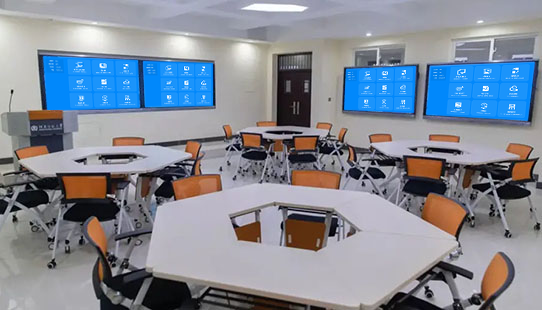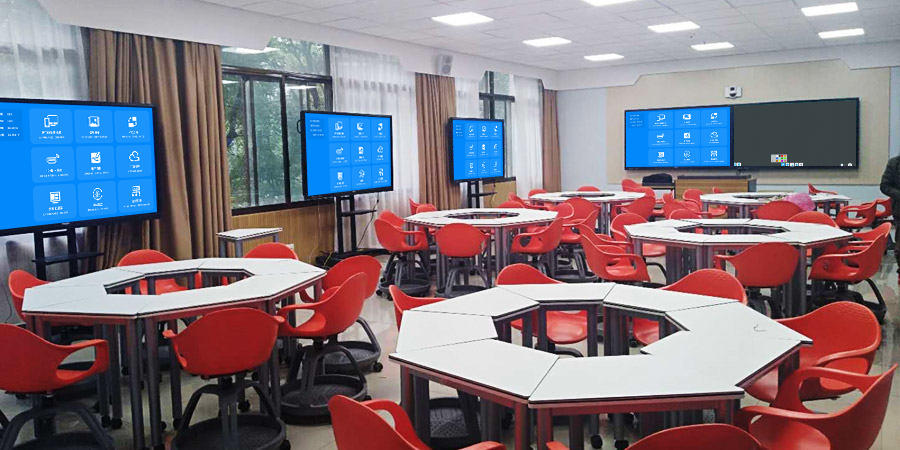Multi-Screen Interaction: A Cross-Device Collaborative Interaction Solution
The multi-screen interaction solution, powered by Bijie’s core technology, breaks through the system barriers of devices like phones, computers, tablets, and large screens. It builds a collaborative ecosystem of “seamless content flow, two-way control, and deep scenario adaptation,” providing an efficient interactive tool for office, education, and design scenarios.
Core Technology Architecture
- Universal Protocol Compatibility Engine: It supports 8 protocols, including AirPlay, Miracast, DLNA, and WiDi, covering all systems like iOS, Android, Windows, and macOS. Older devices are compatible through a QR code direct connection function, with a device adaptation rate of 99.8%.
- Low-Latency Transmission Protocol: It uses a proprietary high-speed transmission technology, with latency ≤30ms at 4K quality and an audio-visual synchronization error of <100ms. This ensures smooth mirroring of dynamic content, meeting the high-precision needs of displaying design blueprints and real-time data presentations.
- Distributed Interactive System: It supports up to 16 devices connecting simultaneously. Through a “master-slave control” mechanism, it enables tiered permissions. The main screen can take over the operation of a smaller screen, and a smaller screen can remotely control the functions of the large screen, making multi-device collaboration feel like using a single terminal.
Key Collaboration Features
- Intelligent Content Migration: Content like documents, videos, and annotations can be migrated between multiple screens with one click, while maintaining the continuity of their editing status. For example, client requirements annotated on a phone can be seamlessly synced to a proposal document on a computer, and a hand-drawn design sketch on a tablet can be directly projected onto a large screen for team review.
- Real-Time Annotation Linkage: It supports up to 8 people annotating the same content on different devices simultaneously. Annotations are distinguished by different colors and synchronized to all screens in real time. In a meeting, the presenter can annotate key points of a proposal on the main screen, and participants can add their comments on their respective terminals. The collaboration history is fully traceable.
- Multi-Screen Aggregation Display: It provides layout modes such as 4-split screen and 9-split screen. The system intelligently identifies content types and presents them in a categorized manner. In an office, you can display client data, data analysis tables, and communication records at the same time. In a classroom, you can simultaneously project courseware, student assignments, and quiz data, boosting information retrieval efficiency by 60%.

Scenario-Based Implementation Solutions
(I) Enterprise Meeting Scenarios
- Executive Decision-Making Meetings: Executives from global branches can connect via the multi-screen interaction system. The main screen displays a split-screen view of the presenter’s proposal, a remote video feed, and real-time voting results. Off-site teams can annotate revision suggestions via their phones, shortening the decision-making cycle by 40%.
- Departmental Collaboration Meetings: Terminals from the marketing, R&D, and sales departments can connect to the conference screen at the same time. Their data charts are compared in a split-screen view on the main screen, which aggregates the points of difference in real time, increasing cross-departmental coordination efficiency by 50%.
(II) Smart Education Scenarios
- Interactive Classrooms: After a teacher mirrors courseware from a tablet, students can submit their answers on their terminals, and the main screen generates an accuracy analysis in 3 seconds. Group discussion results can be displayed in a split-screen view, and the teacher can use a stylus to annotate in real time, increasing classroom participation by 70%.
- Remote Study Tours: Urban and rural students can share experimental data via the multi-screen system. Their mirrored observation records are compared and analyzed on the main screen in a split-screen view, allowing for the efficient flow of quality educational resources.
(III) Creative Design Scenarios
- Proposal Review Meetings: A designer can use a tablet to present a draft, mirror it to a computer for detailed refinement, and then sync it to a large screen for client review. The client can use a phone to annotate revision suggestions, and the system automatically generates a revision list, shortening the design iteration cycle by 30%.
- Cross-Regional Collaboration: Design teams from different cities can share 3D models via the multi-screen system. Their rotation and zoom operations on their respective terminals are synchronized to the main screen in real time, making remote collaboration feel like an in-person discussion.
Management and Security System
- Granular Permission Control: Permissions are tiered for “administrator – user – visitor.” In an enterprise scenario, regular employees can only mirror content, while the administrator can control device connection permissions. In a teaching scenario, student terminals are restricted from pushing irrelevant content to ensure order.
- Encrypted Data Transmission: End-to-end encryption using AES-256 is used to protect content transmitted across screens. It supports hardware-level secure chip storage of sensitive data and complies with the ISO27001 information security standard, preventing the leakage of trade secrets and educational data.
- Smart Operations and Maintenance Platform: An administrator can remotely monitor data such as device connection status, annotation records, and fault alarms. It supports batch firmware upgrades and parameter optimization, reducing maintenance costs by 60% and achieving a system availability of 99.9%.
The multi-screen interaction solution, empowered by technology, transforms fragmented device resources into a collaborative whole, upgrading collaboration from “taking turns” to “synchronized co-creation.” Whether for efficient decision-making in an enterprise, in-depth teaching at a school, or a creative brainstorming session for a design team, it delivers a dual upgrade in efficiency and experience.